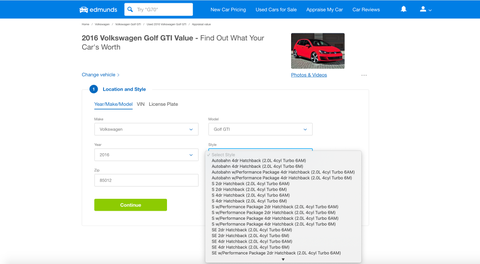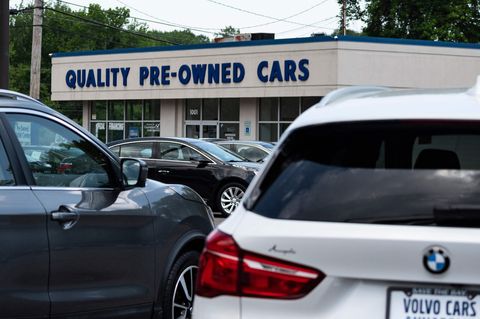If you’ve found yourself in need of a vehicle since the pandemic started, you likely know that we’re in one of the worst times to buy, due in part to the chip shortage that’s taken the automotive industry out at the knees. As we’ve been emerging from the dark depths of the pandemic, pent-up demand for vehicles is driving customers to buy in greater numbers than ever before. Reeling from that perfect storm of parts shortages and unprecedented demand, the automotive market could stay upside down well into 2022.
Having said that, there’s plenty to look out for that will help you find a great set of wheels at a relatively reasonable price. As long as you approach your purchase with an open mind, willing to compromise, you’ll find that things aren’t as bad as they may seem.
As the Popular Mechanics Autos Editor, I keep my finger on the pulse of what’s going on in the industry. And to get a deeper look at and other expert perspectives on the challenges facing the market, I consulted Jessica Caldwell, executive director of insights at Edmunds, and Mark Gillies, head of product and technology communications at Volkswagen USA. Along with scouring other resources like Edmunds, Kelly Blue Book, and Car Gurus, I’ve put together this guide on how to get a great deal if you’re on the hunt.
How Did It Happen?
To explain the current chip shortage, we need to flashback to the early days of the pandemic in 2020. As we were told to stay home for long periods of time, automakers began shutting down factories. And because of that, they slowed down orders for parts (including semiconductors) to cope. Aside from the obvious unknowns, manufacturers assumed that vehicle demand would remain low as there was little to no reason to leave the house.
Lo and behold, these newfound allotments for semiconductors were snatched up by companies in the tech sector. After automakers found out that people were getting stir crazy and buying RVs and vans in record numbers—Mercedes Sprinter sales increased 22.5 percent in 2020 alone—they realized that it was too late to reclaim their stake. The entire automotive industry only accounts for about 10 percent of the market share for semiconductors, meaning that the companies don’t have a seat at the table to bargain for more chips—no pun intended. While some industry giants like Toyota successfully predicted the shortage by stockpiling components, those stores are starting to run low.
As of right now, Edmunds reports new-vehicle inventory is down about 75 percent from where it was in 2019. However, despite dealerships having a mere fraction of their normal stock, inventory has remained relatively steady around that point. With such low inventory, the average transaction price for new vehicles in November of 2021 was nearing $46,000—up nearly 15 percent from this point last year.
Why Is It Such A Big Deal?
While knowledge of the chip shortage is widespread, it seems that there’s a little bit of a disconnect on why it’s making such a big impact in the automotive space. But it’s relatively simple.
The word “chip” refers to the tiny microprocessors that control various systems of your automobile. Think of them then as the brains of the car. The majority of systems in your vehicle use computer chips—including tire pressure monitors, infotainment systems, vehicle dynamics systems, and much more—to function properly. One of the most involved electronic systems is the Engine Control Unit (ECU). Its most basic function involves controlling fuel injection and the amount of spark needed to ignite it. (Before electronic fuel injection was commonplace, this process was tunable mechanically via a carburetor.) To offer some perspective on how crucial these chips are, Car and Driver estimates that 40 percent of the list price for modern automobiles is for the electronics alone.
Mark Gillies says Volkswagen and many other automakers are coping with the shortage by prioritizing chips for higher-value models. The company is giving vehicles like the Tiguan precedence over less-premium ones like the Jetta. Unlike many other manufacturers that are omitting certain options to cut their losses, VW is sometimes fitting nicer bits to some of its cars because it’s all it can get its hands on. Case in point: Atlas models will receive the higher-tier version of the digital dashboard, but without any noticeable hike in price.
“At the end of the day, there’s more demand than there is supply, so you’re just trying to build as many cars as you can,” says Gillies.
As I mentioned, other automakers are attacking the shortage by building cars without some of the electronic systems that you might expect. Whether that’s forgoing heated seats, a digital dashboard, or even a touchscreen, the main goal is to continue delivering a steady stream of vehicles to dealerships. According to Caldwell, the omission of these items—or “de-contenting,” as they say in the industry—can lead to a decrease in price, but nothing very considerable. She mentioned that she hasn’t yet seen a noteworthy decrease in aggregate pricing for automakers that are doing this.
What You Can Do
If you’re staring down a vehicle purchase either due to necessity or desire, the best thing you can do for yourself is go in with an open mind.
If you’re able to, trade in your existing set of wheels and push for as much return as you can get. According to Caldwell, trade-in values are sky-high; dealerships are already strapped when it comes to getting vehicles in their lot, meaning they’re willing to pay more for yours. Surf around on car resale websites like CarGurus, AutoTrader, and Edmunds to get a good feel for what your vehicle is really worth. I’d gravitate toward Edmunds’s appraisal tool for its ease of use and the vast depth of data they have from dealer transactions—covering just about any make and model you can think of back to 1990.
Since inventory is limited, there’s a good chance you’ll be unable to spec the options and colors that you had in mind. Therefore, be ready with a second choice picked out for colors, option packages, wheels, and even models.
If you’re loyal to a certain brand, now might be the time to give that up and sign a lease with another. Shopping around could lead to considerable savings, giving you more model options (and, therefore, prices) to choose from. While it might feel strange and unfaithful to a brand you love, you can always go back when your lease is up. However, if you’re lucky enough to already be in a lease, Caldwell says going for a lease extension program will save you a considerable amount over buying new. Even for just a one-year extension, you’ll likely be able to keep the same monthly payments.
And, while it’s probably not what you want to hear, you might be better off waiting to buy until the automotive industry has righted itself, if all else fails. Hanging onto your vehicle for another couple of years can save you quite a bit of cash. Edmunds says that as long as demand stays well above supply, dealerships have little reason to discount any product. In my conversation with Gillies at Volkswagen, he said they’ve forecasted that we won’t see substantial improvement in the supply chain until halfway through 2022. The point being: Dealer mark-ups well above list price are going to stick around for quite a while, and buyers have less bargaining power due to the demand.
New or Used?
While you may think that getting a used vehicle will be a way around the chip shortage, you’re unfortunately still out of luck. After buyers steered clear of the new market, they proceeded to look for more-affordable used automobiles. It won’t surprise you then that the used market now carries the same high demand, low stock log jam as the new market. According to Edmunds, the average transaction price for a used vehicle in June of this year was $26,457 (an increase of 27 percent from that point in 2020). Caldwell noted that dealers are selling approximately 2.5 times more used cars than new cars.
Best of Luck
The unfortunate eventuality for the foreseeable future is that you’ll be paying a pretty penny for any vehicle regardless of whether it’s new or used. If you absolutely need some wheels right now, capitalize on the best deal that you can find. Some good news is that inventory hasn’t been getting any worse as of late. Until the industry begins to show relative signs of improvement, these tips and tricks will help you make the most of your next car purchase.
This content is created and maintained by a third party, and imported onto this page to help users provide their email addresses. You may be able to find more information about this and similar content at piano.io


